manual transmission TOYOTA YARIS 2008 2.G Owners Manual
[x] Cancel search | Manufacturer: TOYOTA, Model Year: 2008, Model line: YARIS, Model: TOYOTA YARIS 2008 2.GPages: 388, PDF Size: 7.34 MB
Page 2 of 388

TABLE OF CONTENTSIndex
2
1-1. Key information .................. 26Keys ..................................... 26
1-2. Opening, closing and locking
the doors ........................... 28
Wireless remote control ....... 28
Side doors ............................ 31
Back door ............................. 35
1-3. Adjustable components
(seats, mirrors, steering
wheel) ................................ 37
Front seats ........................... 37
Rear seats ............................ 40
Head restraints ..................... 45
Seat belts ............................. 48
Steering wheel ..................... 58
Anti-glare inside rear view mirror .................................. 59
Outside rear view mirrors ..... 60
1-4. Opening and closing the window s ............................ 63
Power windows .................... 63
1-5. Refueling ............................. 66 Opening the fuel tank cap .... 66
1-6. Theft deterrent system ...... 70 Engine immobilizer system ................................ 70
Alarm (Puerto Rico).............. 72
Theft prevention labels (except Canada) ................ 74 1-7. Safety information .............. 75
Correct driving posture ......... 75
SRS airbags ......................... 77
Front passenger occupant classification system ........... 89
Child restraint systems ......... 94
Installing child restraints ....... 98
2-1. Driving procedures........... 110 Driving the vehicle .............. 110
Engine (ignition) switch....... 119
Automatic
Transmission...... 123
Manual Transmission ......... 125
Turn signal lever ................. 126
Parking brake ..................... 127
2-2. Instrument cluster ............ 129 Gauges and meters ............ 129
Indicators and warning lights ................................. 135
2-3. Operating the lights and wipers .............................. 139
Headlight switch ................. 139
Fog light switch ................... 141
Windshield wipers and washer .............................. 142
Rear window wiper and washer ............................. 144
2-4. Using other driving systems ........................... 145
Driving assist systems ........ 145
1Before driving
2When driving
Page 3 of 388

1
2
3
4
5
6
7
3
2-5. Driving information ........... 147Cargo and luggage ............. 147
Vehicle load limits ............... 150
Winter driving tips ............... 151
Trailer towing (except Canada) ............... 155
Trailer towing (Canada) ...... 156
Dinghy towing (vehicles with an automatic
transmission) .................... 164
Dinghy towing (vehicles with a manual
transmission) .................... 165
3-1. Using the air conditioning system and defogger...... 168
Air conditioning system ....... 168
Rear window defogger ........ 175
3-2. Using the audio system.... 176 Audio system types ............. 176
Using the radio .................... 179
Using the cassette player.... 182
Using the CD player ............ 185
Playing back MP3 and WMA discs ........................ 192
Optimal use of the audio system .............................. 200
Using the AUX adapter ....... 203
3-3. Using the interior lights.... 204 Interior lights list .................. 204
• Interior light .......................205
• Personal lights ...................205 3-4. Using the storage
features ........................... 206
List of storage features ....... 206
• Glove boxes ..................... 206
• Cup holders ...................... 208
• Bottle holders ................... 209
• Auxiliary boxes ................. 211
3-5. Other interior features ..... 213 Sun visors........................... 213
Vanity mirrors ..................... 214
Clock .................................. 215
Power outlet ....................... 217
Floor mat ............................ 218
Luggage compartment features ............................ 219
4-1. Maintenance and care ...... 222 Cleaning and protecting the vehicle exterior ................. 222
Cleaning and protecting the vehicle interior .................. 224
4-2. Maintenance...................... 227 Maintenance requirements .................... 227
General maintenance ......... 229
Emission inspection and maintenance (I/M)
programs .......................... 232
3Interior features
4Maintenance and care
Page 109 of 388
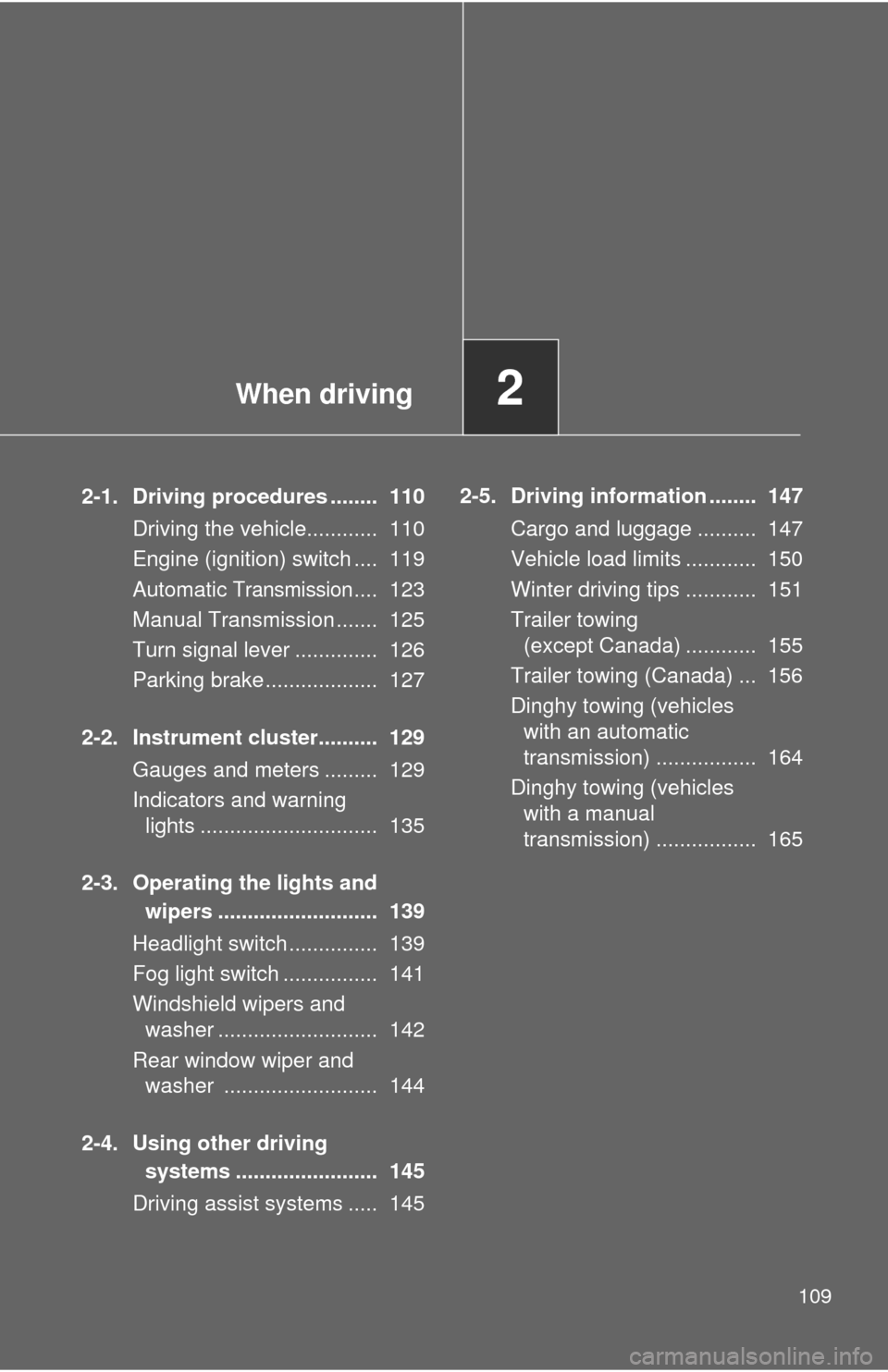
When driving2
109
2-1. Driving procedures ........ 110Driving the vehicle............ 110
Engine (ignition) switch .... 119
Automatic
Transmission.... 123
Manual Transmission ....... 125
Turn signal lever .............. 126
Parking brake ................... 127
2-2. Instrument cluster.......... 129 Gauges and meters ......... 129
Indicators and warning lights .............................. 135
2-3. Operating the lights and wipers ........................... 139
Headlight switch ............... 139
Fog light switch ................ 141
Windshield wipers and washer ........................... 142
Rear window wiper and washer .......................... 144
2-4. Using other driving systems ........................ 145
Driving assist systems ..... 145 2-5. Driving information ........ 147
Cargo and luggage .......... 147
Vehicle load limits ............ 150
Winter driving tips ............ 151
Trailer towing (except Canada) ............ 155
Trailer towing (Canada) ... 156
Dinghy towing (vehicles with an automatic
transmission) ................. 164
Dinghy towing (vehicles with a manual
transmission) ................. 165
Page 110 of 388
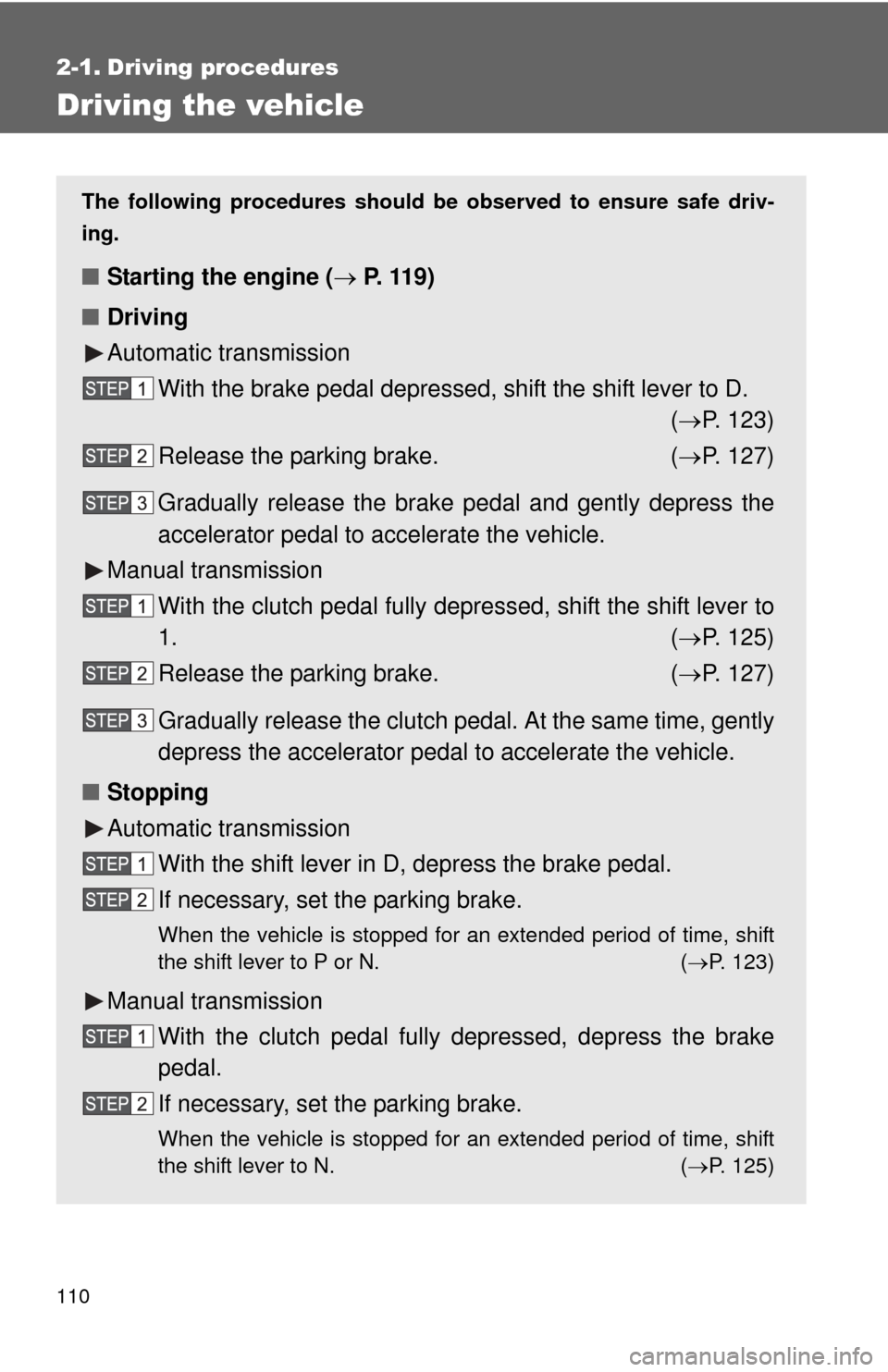
110
2-1. Driving procedures
Driving the vehicle
The following procedures should be observed to ensure safe driv-
ing.
■ Starting the engine ( P. 119)
■ Driving
Automatic transmission
With the brake pedal depressed, shift the shift lever to D. ( P. 123)
Release the parking brake. ( P. 127)
Gradually release the brake pedal and gently depress the
accelerator pedal to accelerate the vehicle.
Manual transmission With the clutch pedal fully depressed, shift the shift lever to
1. ( P. 125)
Release the parking brake. ( P. 127)
Gradually release the clutch pedal. At the same time, gently
depress the accelerator pedal to accelerate the vehicle.
■ Stopping
Automatic transmission
With the shift lever in D, depress the brake pedal.
If necessary, set the parking brake.
When the vehicle is stopped for an extended period of time, shift
the shift lever to P or N. ( P. 123)
Manual transmission
With the clutch pedal fully depressed, depress the brake
pedal.
If necessary, set the parking brake.
When the vehicle is stopped for an extended period of time, shift
the shift lever to N. ( P. 125)
Page 111 of 388
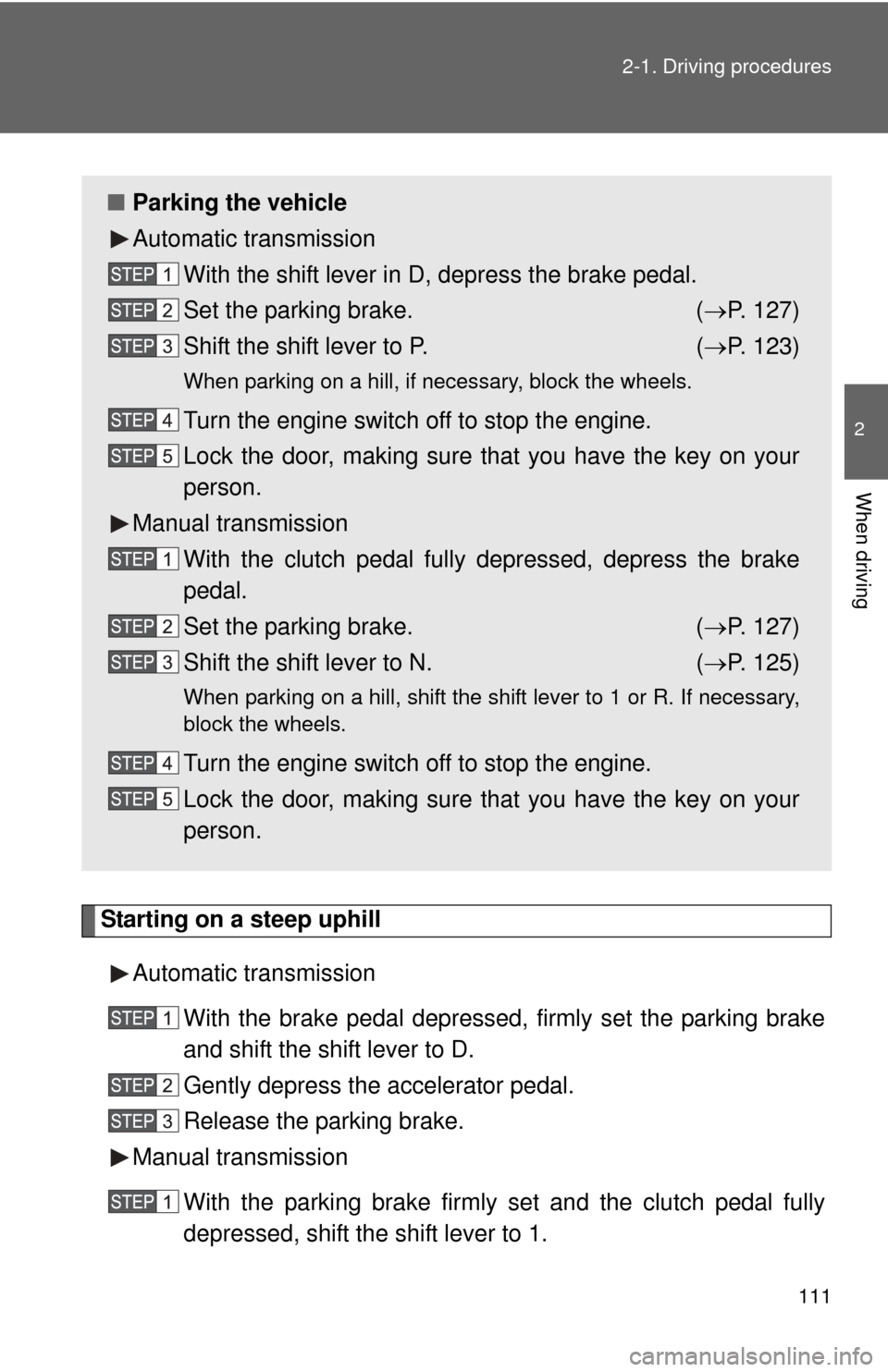
111
2-1. Driving procedures
2
When driving
Starting on a steep uphill
Automatic transmission With the brake pedal depressed, firmly set the parking brake
and shift the shift lever to D.
Gently depress the accelerator pedal.
Release the parking brake.
Manual transmission
With the parking brake firmly set and the clutch pedal fully
depressed, shift the shift lever to 1.
■Parking the vehicle
Automatic transmission
With the shift lever in D, depress the brake pedal.
Set the parking brake. ( P. 127)
Shift the shift lever to P. ( P. 123)
When parking on a hill, if necessary, block the wheels.
Turn the engine switch off to stop the engine.
Lock the door, making sure that you have the key on your
person.
Manual transmission
With the clutch pedal fully depressed, depress the brake
pedal.
Set the parking brake. ( P. 127)
Shift the shift lever to N. ( P. 125)
When parking on a hill, shift the shift lever to 1 or R. If necessary,
block the wheels.
Turn the engine switch off to stop the engine.
Lock the door, making sure that you have the key on your
person.
Page 113 of 388

113
2-1. Driving procedures
2
When driving
CAUTION
■
When starting the vehicle
Vehicles with an automatic transmission, always keep your foot on the brake
pedal while stopped with the engine running. This prevents the vehicle from
creeping.
■ When driving the vehicle
●Do not drive if you are unfamiliar with the location of the clutch, brake and
accelerator pedals to avoid depressing the wrong pedal.
• Accidentally depressing the accelerator pedal instead of the brake
pedal will result in sudden acceleration that may lead to an accident
that could result in death or serious injury.
• When backing up, you may twist your body around, leading to a diffi- culty in operating the pedals. Make sure to operate the pedals properly.
• Make sure to keep a correct driving posture even when moving the vehicle only slightly, allowing you to depress the brake and accelerator
pedals properly.
• Depress the brake pedal using your right foot. Depressing the brake pedal using your left foot may delay response in an emergency, result-
ing in an accident.
● Do not drive the vehicle over or st op the vehicle near flammable materials.
The exhaust system and exhaust gases can be extremely hot. This may
cause a fire if there is any flammable material nearby.
● Vehicles with an automatic transmission, do not let the vehicle roll back-
wards while the shift lever is in a driving position, or roll forward while the
shift lever is in R.
Doing so may cause the engine to stall or lead to poor brake and steering
performance, resulting in an accident or damage to the vehicle.
● If the smell of exhaust is noticed inside the vehicle, open the windows and
check that the back door is closed. Large amounts of exhaust in the vehi-
cle can cause driver drowsiness and an accident, resulting in death or a
serious health hazard. Have the vehicle inspected by your Toyota dealer
immediately.
● Do not under any circumstances shift the shift lever to P, R or N (automatic
transmission) or R (manual transmission) while the vehicle is moving.
Doing so can cause significant damage to the transmission system and
may result in a loss of vehicle control.
Page 117 of 388

117
2-1. Driving procedures
2
When driving
CAUTION
■
When braking the vehicle
●If the power brake assist function does not operate, do not follow other
vehicles closely and avoid downhills or sharp turns that require braking.
In this case, braking is still possible, but it will require more force on the
pedal than usual. Braking distance may also increase.
● Do not pump the brake pedal if the engine stalls.
Each push on the brake pedal uses up the reserve for the power-assisted
brakes.
● The brake system consists of 2 individual hydraulic systems: If one of the
systems fails, the other will still operate. In this case, the brake pedal
should be depressed more firmly than usual and braking distance
becomes longer.
Do not drive your vehicle with only a single brake system. Have your
brakes fixed immediately.
NOTICE
■When driving the vehicle
Vehicles with a manual transmission
● Do not rest your foot on the clutch pedal while driving.
Doing so may cause clutch trouble.
● Do not use any gears other than the first gear when starting off and mov-
ing forward.
Doing so may damage the clutch.
● Do not use the clutch to hold the vehicle when stopping on an uphill grade.
Doing so may damage the clutch.
Vehicles with an automatic transmission
● Do not use the accelerator pedal or depress accelerator and brake pedals
together to hold the vehicle on a hill.
■ When parking the vehicle
Vehicles with an automatic transmission: Always put the shift lever in P.
Failure to do so may cause the vehicle to move or the vehicle may acceler-
ate suddenly if the accelerator pedal is accidentally depressed.
Page 120 of 388
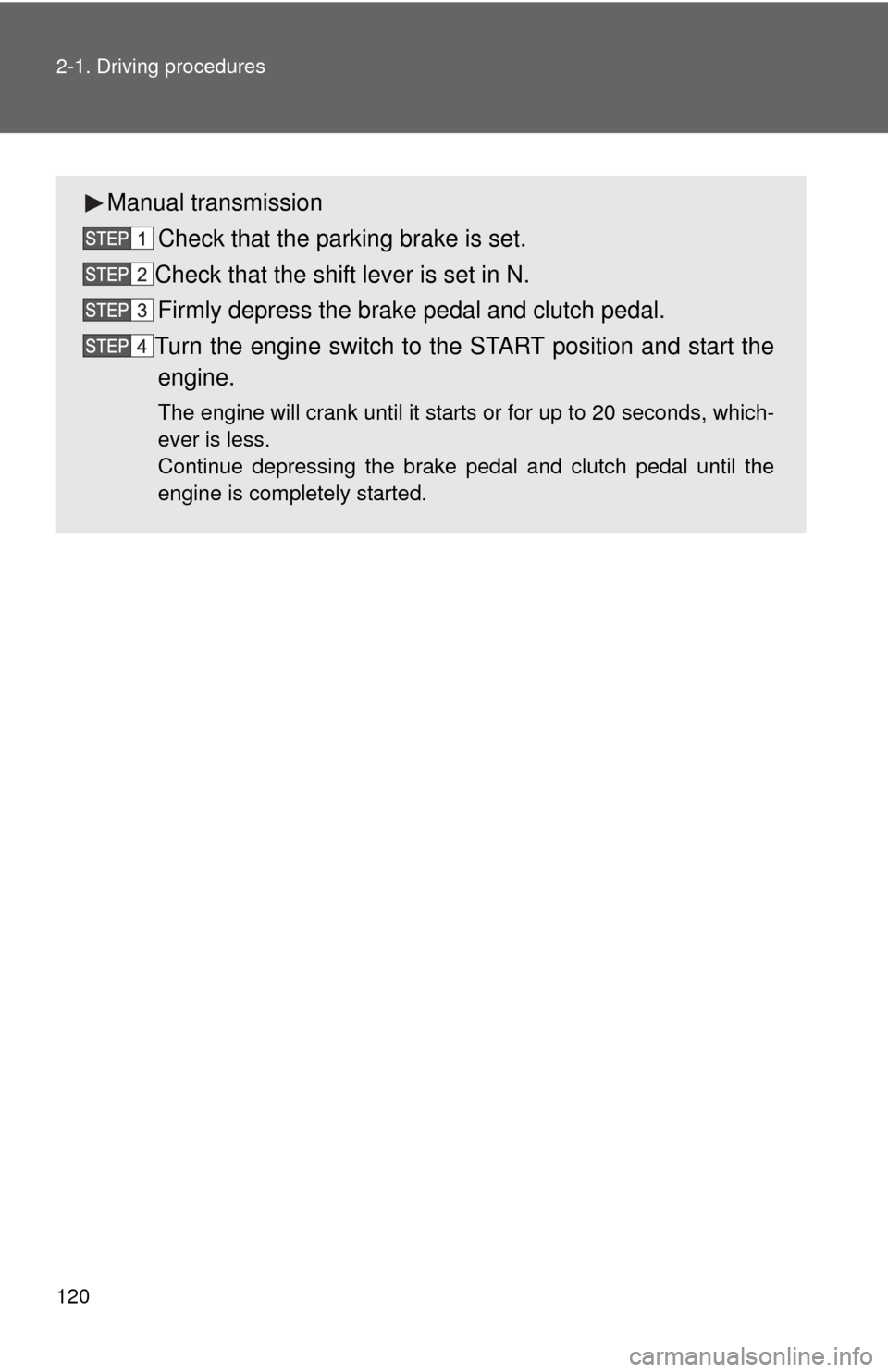
120 2-1. Driving procedures
Manual transmissionCheck that the parking brake is set.
Check that the shift lever is set in N. Firmly depress the brake pedal and clutch pedal.
Turn the engine switch to the START position and start the engine.
The engine will crank until it starts or for up to 20 seconds, which-
ever is less.
Continue depressing the brake pedal and clutch pedal until the
engine is completely started.
Page 125 of 388
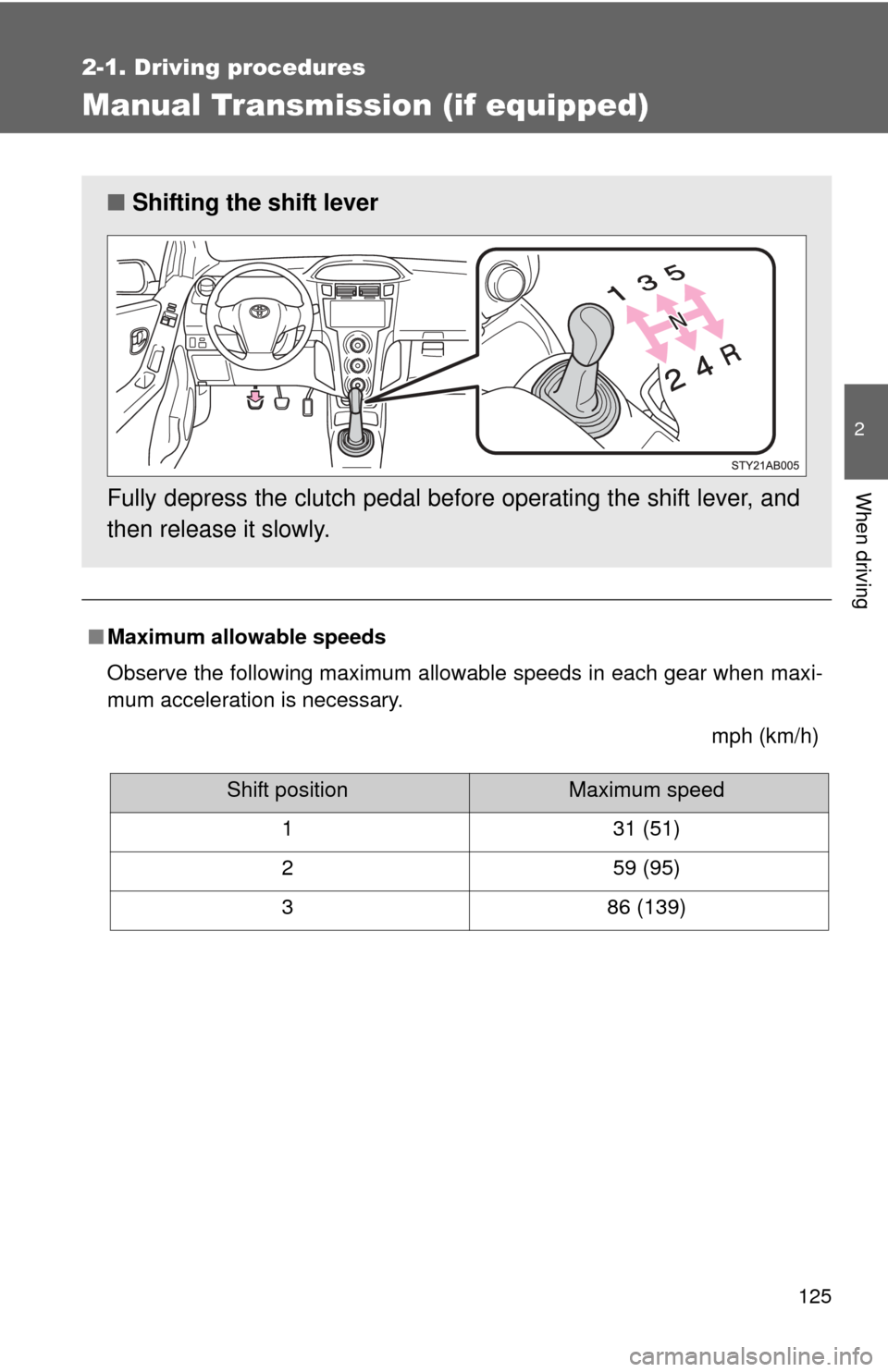
125
2-1. Driving procedures
2
When driving
Manual Transmission (if equipped)
■Maximum allowable speeds
Observe the following maximum allowable speeds in each gear when maxi-
mum acceleration is necessary.
mph (km/h)
■Shifting the shift lever
Fully depress the clutch pedal before operating the shift lever, and
then release it slowly.
Shift positionMaximum speed
1 31 (51)
2 59 (95)
3 86 (139)
Page 152 of 388

152 2-5. Driving information
Regulations on the use of snow chains● Regulations regarding the use of tire chains vary according to loca-
tion and type of road. Always check local regu lations before install-
ing chains.
● Use SAE Class “S” type radial tire chains, with the exception of
radial cable chains or V-bar type chains.
• Install the chains on the front tires.
• Refer to the explanation that comes with the tire chains for
installation instructions.
● Retighten the chains after drivi ng 1/4 - 1/2 mile (0.5 - 1.0 km).
■When driving the vehicle
Accelerate the vehicle slowly and drive at a reduced speed suit-
able to road conditions.
■ When parking the vehicle
Park the vehicle and move the shift lever to P (automatic trans-
mission) or to 1 or R (manual transmission) without setting the
parking brake. The parking brak e may freeze up, preventing it
from being released.